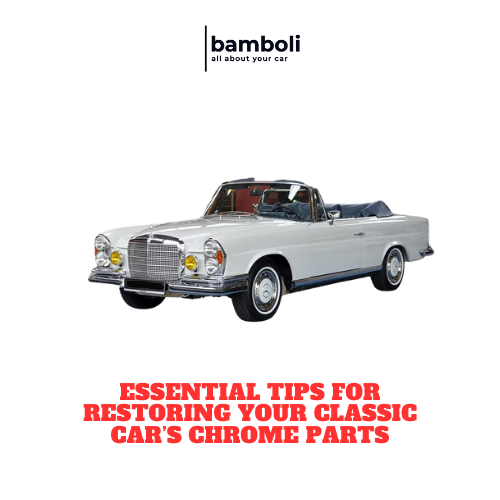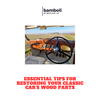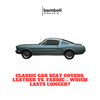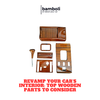Essential Tips for Restoring Your Classic Car’s Chrome Parts

Essential Tips for Restoring Your Classic Car’s Chrome Parts
Classic cars are cherished for their timeless beauty and intricate details, including their stunning chrome parts. Over time, these chrome elements can lose their luster due to oxidation, rust, and grime. Restoring the chrome on your classic car can revive its original appeal and add significant value. This guide offers essential tips for cleaning, polishing, and protecting chrome parts, ensuring your classic car shines as brightly as it did in its heyday.
Understanding Chrome Restoration
Restoring chrome involves several steps: cleaning, polishing, and protecting. Each step requires specific tools and materials to achieve the best results.
Tools and Materials Needed
- Mild Detergent: For initial cleaning to remove dirt and grime.
- Chrome Polish: To restore shine and remove oxidation.
- Aluminum Foil: An old-school trick for removing rust.
- Microfiber Cloths: For cleaning and polishing without scratching.
- Protective Coating: To maintain the shine and protect against future damage.
- Rust Remover: For tackling more severe rust spots.
- Soft Bristle Brush: To reach into crevices and detailed areas.
Step-by-Step Restoration Guide
Step 1: Initial Cleaning
- Prepare Cleaning Solution: Mix mild detergent with warm water.
- Wash Chrome Parts: Use a microfiber cloth to wash the chrome parts, removing dirt and grime. Be gentle to avoid scratching the surface.
- Rinse and Dry: Rinse thoroughly with clean water and dry with a microfiber cloth to prevent water spots.
Step 2: Rust Removal
- Inspect for Rust: Identify areas with rust. Light rust can often be removed with aluminum foil.
- Aluminum Foil Method: Dip aluminum foil in water and gently rub the rusted area. The chemical reaction between the aluminum and rust helps lift the rust without scratching the chrome.
- Use Rust Remover: For more severe rust, apply a commercial rust remover according to the product’s instructions. Use a soft bristle brush to work the remover into the rust, then rinse and dry thoroughly.
Comparison Table: Rust Removal Methods
|
Method |
Benefits |
Ideal For |
|
Aluminum Foil |
Gentle, effective for light rust |
Small, lightly rusted areas |
|
Rust Remover |
Powerful, handles severe rust |
Deep rust spots, larger surfaces |
Step 3: Polishing
- Apply Chrome Polish: Apply a small amount of chrome polish to a microfiber cloth.
- Polish in Circular Motions: Gently polish the chrome in circular motions, covering the entire surface. Focus on one small area at a time.
- Buff to Shine: Use a clean microfiber cloth to buff the chrome, enhancing its shine and removing any residue.
Comparison Table: Chrome Polishing Products
|
Product Type |
Benefits |
Best Use |
|
Chrome Polish |
Restores shine, removes light oxidation |
General polishing |
|
Chrome Sealant |
Adds protective layer, enhances durability |
Long-term protection |
|
Metal Polish Paste |
Intensive polishing, handles severe oxidation |
Deep cleaning and restoration |
Protecting Chrome Parts
Step 4: Applying Protective Coating
- Choose a Protective Coating: Select a high-quality chrome protectant or sealant.
- Apply Evenly: Apply the protectant evenly across the chrome surface using a microfiber cloth.
- Let it Cure: Allow the coating to cure according to the product’s instructions. This forms a protective barrier against moisture and contaminants.
- Buff Again: After curing, buff the surface with a clean cloth to enhance the shine.
Regular Maintenance Tips
- Frequent Cleaning: Regularly clean the chrome parts with a mild detergent to prevent dirt buildup and corrosion.
- Quick Response to Rust: Address any signs of rust immediately to prevent further damage.
- Avoid Abrasive Materials: Never use abrasive cleaners or tools that can scratch the chrome.
- Protect from Elements: When possible, store your classic car in a garage or use a car cover to protect it from harsh weather conditions.
Tips for Effective Chrome Restoration
- Work in Small Sections: Focus on small areas to ensure thorough cleaning and polishing.
- Test Products First: Always test cleaning and polishing products on a small, inconspicuous area to ensure they do not damage the chrome.
- Use Proper Lighting: Good lighting helps you see all areas clearly, ensuring you don’t miss any spots.
- Be Patient: Take your time with each step to achieve the best results.
Additional Tools for Chrome Restoration
- Detailing Brushes: For intricate parts and hard-to-reach areas.
- Dremel Tool with Polishing Attachments: For precision polishing in detailed areas.
- Protective Gloves: To protect your hands from chemicals and sharp edges.
Making Your Chrome Shine Again
Restoring and maintaining the chrome parts of your classic car is essential for preserving its beauty and value. Here are some additional detailed steps and tips for achieving that mirror-like finish:
Step 5: Deep Cleaning
For chrome parts that have been neglected or are heavily tarnished, a deep cleaning step can help:
- Use Baking Soda Paste: Mix baking soda with water to form a paste. Apply this paste to the chrome and let it sit for 15 minutes.
- Scrub Gently: Use a soft bristle brush to scrub the paste gently into the chrome. This helps remove deep-seated grime without scratching.
- Rinse Thoroughly: Rinse the chrome with clean water and dry with a microfiber cloth.
Step 6: Using Chrome Polish
Chrome polish is designed to restore the shine and remove light oxidation:
- Apply a Small Amount: Squeeze a small amount of chrome polish onto a microfiber cloth.
- Polish in Circles: Rub the polish onto the chrome in small, circular motions. Work in small sections to ensure even coverage.
- Let it Sit: Allow the polish to sit for a few minutes, as per the instructions on the product.
- Buff Off: Buff off the polish with a clean microfiber cloth to reveal a bright, reflective finish.
Step 7: Protecting Your Chrome
Applying a protective coating helps maintain the shine and prevent future tarnish:
- Select a Chrome Protectant: Choose a high-quality chrome protectant or sealant from a reputable brand.
- Apply Evenly: Spread the protectant evenly over the chrome using a microfiber cloth.
- Cure Time: Allow the protectant to cure as directed by the product instructions.
- Final Buff: Buff the chrome one last time with a clean cloth to enhance the protective layer and shine.
Long-Term Chrome Maintenance
To keep your chrome looking great over the long term, consider these additional maintenance tips:
- Avoid Harsh Chemicals: Use only mild detergents and chrome-specific cleaning products.
- Regular Inspection: Frequently inspect your chrome parts for early signs of rust or tarnish and address them promptly.
- Storage Conditions: Store your classic car in a dry, covered area to protect the chrome from moisture and the elements.
- Waxing: Occasionally wax the chrome parts with a non-abrasive wax to add an extra layer of protection.
Tools and Products Overview
|
Tool/Product |
Purpose |
Best Practice Use |
|
Mild Detergent |
Cleaning without damaging chrome |
Regular cleaning |
|
Chrome Polish |
Restoring shine, removing light oxidation |
Polishing sessions |
|
Aluminum Foil |
Removing light rust |
Small rust spots |
|
Microfiber Cloths |
Scratch-free cleaning and polishing |
General use |
|
Protective Coating |
Long-term protection against tarnish and rust |
After polishing |
|
Rust Remover |
Tackling severe rust spots |
Deep rust areas |
|
Soft Bristle Brush |
Cleaning detailed areas |
Intricate parts and crevices |
|
Detailing Brushes |
Precision cleaning |
Hard-to-reach spots |
|
Dremel Tool |
Precision polishing |
Detailed chrome elements |
|
Protective Gloves |
Hand protection from chemicals |
Throughout restoration process |
By following these steps and utilizing the right tools and products, you can effectively restore and maintain the chrome parts of your classic car. The result will be a vehicle that not only looks stunning but also retains its value and appeal.
Frequently Asked Questions
How often should I clean and polish my classic car’s chrome parts? It’s recommended to clean and polish your car’s chrome parts at least every few months, or more frequently if the car is exposed to harsh conditions.
Can I use household cleaners on chrome? It’s best to use products specifically designed for automotive chrome to avoid damage. Household cleaners can be too harsh and may cause pitting or dullness.
How do I prevent rust from forming on chrome parts? Keep the chrome clean and dry, apply a protective coating regularly, and store the car in a dry, covered area. Address any signs of rust immediately to prevent spread.
Can I restore pitted chrome? Minor pitting can sometimes be polished out, but severe pitting may require re-chroming by a professional. Regular maintenance can prevent pitting from worsening.
What should I do if my chrome parts are heavily rusted? For heavily rusted chrome, professional restoration might be necessary. Severe rust can compromise the integrity of the chrome, requiring expert treatment.




